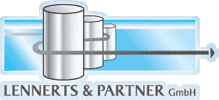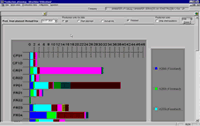Products
LP-System - Technical Part
Moduls:
- Optimization Program for Cutting System
- Online-Downloading to machines
- Offline-Downloading to machines
- Datasummary
The Technical Part was developed in close cooperation with our clients and the help of current data from bending plants of different sizes and structures.
click to enlarge / example of building a production unit
The system allows you to answer ever recurring questions for example
- What is the current degree of utilization of the machines?
- When and for which machines does capacity overload occur?
- Which production time has (had) an order?
- Who produced the seperate positions of the orders?
- In which state of production is a certain order?
- Which diameters have I processed in the space of time XYZ in which quantity?
- Which day´s production did I have on day XYZ?
- Is my machine capacity sufficient for the planned production?
- In which state of production is the position?
that turn up in a bending plant. These questions have a big influence on the planning and controlling of the processes in bending plants.
The answers to these questions which give you a permanent overview over the running production are effected with the help of the areas of function of LP-System. Only a few, essential of these can be named here:
- Freely parameterizable machine park
- Automatic takeover of data from LP-System Commercial Part
- Takeover of CAD-data according to guidelines of the BVBS-Interface
- Optimized, automatic machine allocation (with plausibility check and sequence optimization)
- Manual correction of the allocations
- Arbitrary opportunity to commission orders
- Monitoring and steering of the capacity utilization of the machines
- User definable release of commissions
- Machine steering
- Production summary via bar code
click to enlarge / example of monitoring the utilization
Additionally the use of bar codes enables you to change the working off sequence even after the planning in the production steering. The data transfer to the machines takes place via the existing network cables or a serial cabling.


